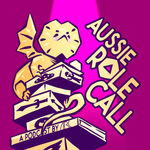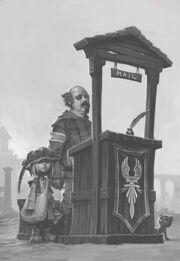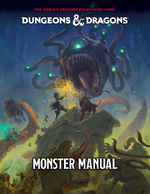Adventurers' Tales

The Aussie Role Call podcast is back for another year, interviewing creators and entrepreneurs in the TTRPG scene in the Land Downunda (it's like the Underdark, but hotter). Brought to you by the Australian Roleplay Community, it's hosted by Dan Machuca, Stevie Schafer, and Kate O'Sullivan of Dungeons & Doctorates and Meeples & Dragons, as well as PAXAus's Crit or Kiss panel. Find it on Spotify or YouTube.
Current Clack

- Wow, where did the time go? We wish we could say it was mostly into those strange other-world matters of real life, but more often than not it was just other areas of wiki life, as well as ample castings of forget spells. Work on The Forgotten Realms Wiki Presents Juniper's Companion to Venturesome Cookery is taking up a lot of our focus and energy and some things have gone on hold, yet it's nearing completion and we can't wait to show you all this big beautiful cookbook of ours. Until then, let's catch up on Current Clacks…
- ItalianKarsus visited Shadowdale, stopping by Warmfires House for a meal cooked by Rendal Ironguard and Crown & Raven Scriveners to have work done by Maervidal Iloster, but apparently got involved in some Zhentish intrigues when he drank some bad wine served by Nildon Baraejhe. We hope he recovers soon.
- SunderedShor took a trip aboard the Blue Glaucus submarine, only to be marooned at the bottom of the sea. Fortunately, this gave plenty of time to learn psionics from a spiritualist: aura sight, body weaponry, among others, and astral projection and metamorphosis might come in handy for an escape.
- ChloeLorde ventured into the ruins of Myth Drannor, donning cloak of sunlight, breath of vitality, the boots called Death's Deferral, and the belt known as Ophael's cincture for protection. She followed the directions of the guide Weikko Brightbeam, battled the undead dwarves of the Eternal Brigade and won a set of bracers of the battlerager, and finally confronted the glabrezu demon Zun'thar the Unbound.
- Artemaz is having a hot time in the City of Brass, entering via the Magma Gate and the Iskalat district, and having a cool-ish drink or three on the Street of the Vine. He took in the view of the flaming Naranj Canal, visited the Plaza of the Silver Chariot and the Palazzo of Stamping Hooves, and wisely avoided Scorpion Alley (it was full of scorpions).
- We say well met to Aeliren, who's been exploring Cormyr and met Magistrate Cornelius Latrimor and Oversword Edric Crastmere of Wheloon, the mysterious peasant girl Ana Brabener of Eveningstar, and the well-named treasure hunter Oriphaun Huntsilver. Aeliren also toured Granwell Keep and Beckside Castle.
- We've got a lot of other new editors to welcome too: Emperorkangxi told as all about the land of Laothan in Malatra; Shulllk heard the tale of the Beast Lord, the ghostly druid Voolad Espiral, while BedlamMarching was frightened off by the ghost of the Sharran priestess Eshayben; M. Alacant traded with Furjur the Flippant; PatoFR voyaged to Thay aboard the Shadovar flying fortress enclave Kolthunral; StorytellerMars adventured with the thri-kreen ranger Kalix; Pandinal read The Making of a Good Tyrant; and AntonKutovoi kept warm beneath a cloak of the yeti.
- And we welcome back others: Topaztube was transformed into a stone cursed creature; Darkwynters was robbed by the apostate cleric Krastius the Heretic; Lurker Z escaped the slaver Hafkris; and Eoliao sailed into Remichispace aboard a spelljammer.
- Until next time, aluve, as the drow say.
Featured Article

The Citadel of Black Ash was a temple to Gilgeam, god-king of Unther, located in the eastern Smoking Mountains near the Black Ash Plain at the apex of a 3-mile-long (5 km) valley filled with waist-deep silty ash, giant monstrous scorpions, and other hazards.
A millennium before Enlil founded the nation of Unther, a clan of dwarven explorers investigating lava tubes deep in the Smoking Mountains inadvertently awakened a great brown wyrm named Vulpomyscan. The dragon enslaved the entire clan and put them to work mining a hoard of gems and building a lair worthy of his cunning and might.
When the expanding Untheric empire eventually encroached upon Vulpomyscan's claimed territory, clashes broke out and the dragon terrorized and plundered the human settlements. Soon after, the god Marduk the Justice Bringer led an army to fight the dragon and defeated him in a titanic battle with heavy loses on both sides. After looting the Citadel, they abandoned it, and it remained forgotten until Gilgeam, son of Enlil, rediscovered it almost a thousand years later and claimed it for himself.
New & Upcoming Releases

The Ultimate Fantasy Bestiary
This revised and expanded Monster Manual contains a horde of creatures for the fifth edition Dungeons & Dragons® game—a monstrous menagerie of familiar favorites like dragons, giants, and mind flayers, plus a host of new monsters like the arch-hag, the blob of annihilation, and the vampire warlock.
Populate your worlds and adventures with the hundreds of monsters provided and let their stories, illustrations, and easy-to-use stat blocks fuel your D&D adventures for years to come.Featured Source

The players are the famed Heroes of Ascore who recently halted the Zhentarim's plans to conquer the Savage Frontier and the Moonsea. Continuing this journey of heroism, they are called upon to protect ambassadors from the Lords' Alliance. In a turn of events, the Zhentarim and their allies regroup, abduct the ambassadors one by one, and "replace" them. The new "ambassadors" of the Lords' Alliance smear the Heroes of Ascore as traitors, and the party must regain their well-earned name. Treasures of the Savage Frontier sees the party reaching new heights, from freeing the oppressed people of Farr Windward to slaying the great white dragon, Freezefire.
Today in the Realms...
...it is 17 Tarsakh, or the 17th of the Claw of Storms. Selûne is a waxing crescent moon ![]() . On this day:
. On this day:
- In 1354 DR, the Four Mages of Felshroun successfully repel an attack on the town by the Red Wizards of Thay.
- In 1373 DR, the town of Highmoon in Deepingdale was attacked by the black dragon Zarlandris. The dragon was narrowly defeated but the Tower of the Rising Moon was destroyed.
Realmslore
- Ardalis the Bent was a wizard agent of the dreaded Zhentarim, who was sent to the Chantry of St. Sammaster near Volkumburgh, along with other mages and troops under the command of Naug-Adar Lychor.
- The woman who was known as the ice-mage Blizzard was a convicted revolutionary and a gladiator in Hillsfar, who, in reality, was the daughter of the city's leader, Maalthiir.
- The Knucklebones Gang of Avernus was a ragtag band that included Mad Maggie, a night hag, two kenku mechanics, a fiendish flesh golem, two conniving imps, a flameskull, and a host of murderous fey.
- Krakengates were massive perpetual gates underneath the Trackless Sea and the Sea of Fallen Stars that allowed Slarkrethel, the kraken leader of the Kraken Society, to move between them, unrestrained by the land and great distances.
- Lorthas Vinewall was a spell-casting member of the Cormanthor Elves, the group that was attempting to reclaim the ancient elven City of Song, Myth Drannor. He aided those who were tasked with finding Eilistraee's Wanderers, a drow group that was allied with the surface elves.
- The Phoenix Gate was an interior gate in the City of Brass, within an interior wall joining the Plume and the Char districts.
- The red dragon named Skarra was killed by the moon elf Haramara Alenuath with just one mundane arrow from her non-magical bow, later simply known as Haramara's bow.
- Uritel was a half-elven druid from the world of Garden who founded a new religion worshiping world-plants like Yggdrasil's Child that held Garden together in its root system.
Featured Image

A rock gnome perfecting his invention.
Welcome
Well met, traveler! This wiki covers the rich and popular Forgotten Realms campaign setting for Dungeons & Dragons from TSR, Inc. and Wizards of the Coast, including Realmslore from the Oriental Adventures, Al-Qadim, Maztica, The Horde, Planescape, and Spelljammer settings, covering sourcebooks, novels, video games, comics, and more across all editions. See the aims and scope of this wiki here.
Follow us on Bluesky, Mastodon, and Twitter to have lore come to you.
Helping Hand
Need help, have a request, or found something not right? Then post a query in the forum, make a request here, or contact an admin.
Note: Edit regularly? Make a Fandom account to see fewer ads.
Beware: This wiki does not provide spoiler warnings.
Contents
- Realmslore
- People—Drizzt, Elminster, all your favorite heroes and villains, and other interesting folk.
- Races—All the races of the Realms, humanoid and monstrous alike.
- Organizations—The Harpers, Zhentarim, and everything in between.
- Creatures—Things that climb, crawl, fly, slither, swim, and usually bite.
- Geography—Faerûn's towns, kingdoms, wildernesses, and more.
- History—From the dawn of the creator races to the present age.
- Deities—The deities of all the pantheons and races.
- Cosmology—The many planes of existence, how they connect, and who inhabits them.
- Magic—Magic in the Forgotten Realms, be it arcane, divine, or stranger arts.
- Items—Gems and jewelry, poisons and potions, weapons and armor, and more. From minor trinkets to artifacts of epic power and renown.
- Maps—Interactive maps of the Realms, from small villages to big cities like Baldur's Gate and Waterdeep to all Faerûn.
- Media
- Novels—All the many novels, short stories, and ebooks set in the Forgotten Realms.
- Sourcebooks—The sourcebooks and adventure modules that detail the world.
- Movies—Honor Among Thieves, Sleep Sound, and future films and series.
- Video games—Classic games like the Baldur's Gate series, Neverwinter Nights and more.
- Comics—Comic book adventures set in the Realms.
- Magazines—The Realms in Dragon and Dungeon magazines.
- Cards—Trading cards and card games featuring the Realms.
- Board games—Punchouts and meeples.
- Authors—The authors of the many novels and sourcebooks.
- Crunch
Helping Out
Well met, sage! Do you see an error? Maybe you know of some missing lore? Perhaps you want to write an article about a favorite subject? Or maybe you want to really get involved. Don't be shy, click "edit" and get in there! If you're new to wikis, then check out the Wikia tutorial. Look at some of the following links to learn about the Forgotten Realms Wiki, how we do things here, and see some of our recent work. Don't worry about making a mistake, experienced editors will catch it and fix it. Just remember we accept only canon and licensed lore, not homebrew or player characters. Don't just copy out the sourcebook, write in your own words. Finally, always give a source for your information, and explain what you've done in the "summary" box. Happy scribing!
|
|
|
